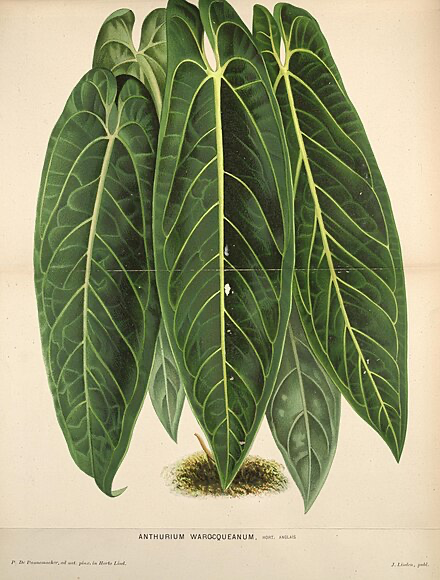
The Queen: Anthurium Warocqueanum
Share
Anthurium warocqueanum, commonly referred to as the “Queen Anthurium,” is a stunning species renowned for its elongated, velvety leaves with striking white venation, though darker cultivars have become more popular in recent years.
The warocqueanum was first collected and documented in the mid-19th century by Gustav Wallis. The plant is native to the tropical rainforests of Colombia, where it thrives as an epiphyte or lithophyte in the humid, shaded understory, and are very rarely found on the ground. Belgian botanists were among the earliest European collectors to encounter this species, transporting it back to Europe during an era of botanical exploration and the Victorian fascination with exotic flora.

The species was named in honor of M. Warocqué, a Belgian horticulturist and plant collector. Warocqué was an influential patron of botanical sciences during the 19th century, and several plants, including Anthurium warocqueanum, bear his name as a tribute to his contributions. The species was formally described by the Austrian botanist Heinrich Wilhelm Schott, who was a leading expert on the Araceae family.
Anthurium warocqueanum is classified within the section Cardiolonchium, which includes other anthurium species characterized by large, elongated, heart-shaped leaves. The plant exhibits significant variation in morphology depending on environmental conditions, with some populations producing longer and narrower leaves than others, leading to regional variations.
Anthurium warocqueanum is primarily recognized for its large, pendant leaves, which can reach lengths 3+ feet (90+ cm) in optimal conditions. The leaves are dark green to almost black, with a distinctive velvety texture, attributed to specialized cells that scatter light, giving the foliage a unique sheen. Prominent, parallel white veins run along the length of the leaf, contributing to the plant’s ornamental appeal.

The species displays dimorphic leaves, with juvenile foliage differing markedly from mature leaves. Juvenile leaves are smaller, more rounded, and lack the characteristic elongated form of mature leaves. This dimorphic trait is an adaptation to the plant’s epiphytic lifestyle, allowing it to acclimate to different light levels as it matures.
In the wild, Anthurium warocqueanum is found growing on tree trunks or rocks, benefiting from the high humidity and indirect light of the tropical forest understory. The plant’s epiphytic nature means it draws moisture and nutrients from the air and surrounding debris, rather than soil. This habitat preference allows it to avoid competition for resources on the forest floor.
Pollination in Anthurium warocqueanum, as with many members of the Araceae family, is facilitated by specialized beetles and other insects attracted to the spadix—a finger-like structure that emerges alongside the plant’s spathe. The spathe, typically greenish-yellow and relatively inconspicuous compared to the species’ striking foliage, serves to protect the spadix and attract pollinators.
Anthurium warocqueanum produces small, fleshy berries as fruit, each containing a few seeds. These fruits are dispersed by animals that feed on them, aiding in the propagation of the plant across its native range.
Due to its specific habitat requirements, Anthurium warocqueanum is sensitive to environmental changes. Deforestation and habitat fragmentation pose threats to wild populations in Colombia. As a result, some populations may face pressures from illegal collection and trade. Conservation efforts, including sustainable cultivation and propagation, are crucial for the long-term preservation of this remarkable species.
Botanical gardens and specialized collectors have focused on cultivating the plant under controlled conditions to reduce wild harvesting. The plant’s slow growth and high demand in the horticultural market make it both a coveted and challenging specimen for botanical collections.
This post provides an overview of the botanical aspects of Anthurium warocqueanum, offering insight into its origins, unique morphology, and role in its native habitat—affirming its status as one of the most cherished and intriguing species among plant enthusiasts and botanists alike.
